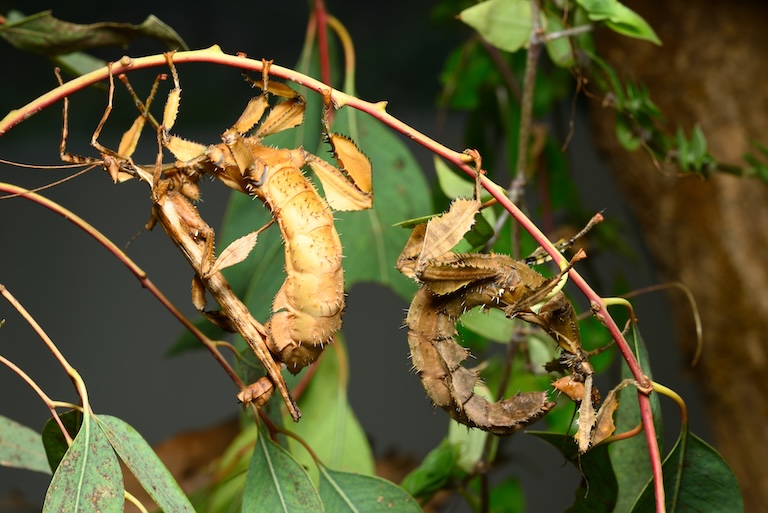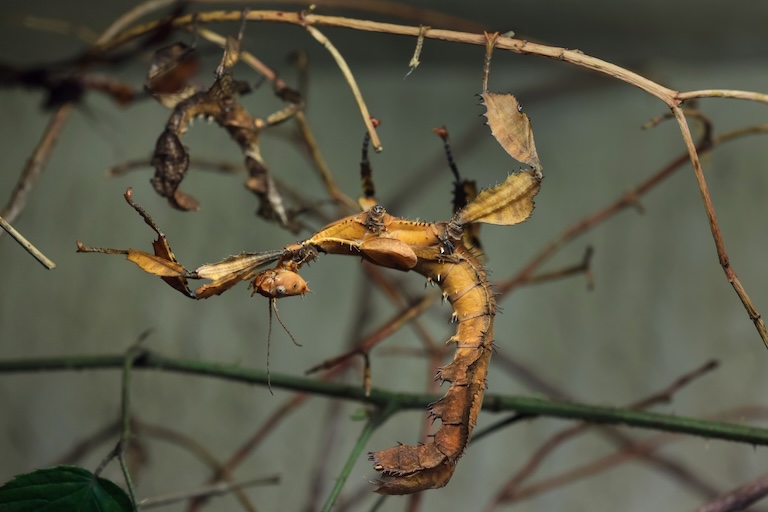Australian Walking Stick Profile
Phasmatids are a curious bunch. They’re generally non-toxic, defenceless, packed with meat and slow-moving, which should make them fair game for anything other than the strictest of vegetarian animals.
But they somehow thrive, and this is due to an arsenal of covert weaponry.
Named because it has a handle at the bottom (not really), the Australian walking stick, or as it’s commonly known by the far less subtle “giant prickly stick insect”, is so diverse in its weirdness that it could have any number of other names.

Australian Walking Stick Facts Overview
| Habitat: | Rainforests |
| Location: | Eastern Australia, from Queensland to Victoria |
| Lifespan: | Up to 18 months in females, around half that in males |
| Size: | Around 20 cm (8 in) long in females, 11 cm (4.5 in) in males |
| Weight: | Around 26 g (1 oz) |
| Colour: | Browns, greens, sometimes slightly yellow |
| Diet: | Primarily Eucalyptus foliage |
| Predators: | Large insects, birds, lizards, arboreal mammals |
| Top Speed: | Slow |
| No. of Species: | 1 |
| Conservation Status: | Least Concern (IUCN) |
The Australian walking stick is a very large species of stick insect.
Females are so large that they can’t fly and instead wander slowly around very much in the way that sticks don’t, pretending to be anything but a stick insect.
As adults, they barely even walk, but as little ‘uns, they scurry about with the best of them, on account of their intimate relationship with seed-eating ants.
Interesting Australian Walking Stick Facts
1. They’re Phasmatids
Phasmatids are weird and wonderful insects, superficially resembling the vegetarian equivalent of praying mantids. The two groups were thought to be related closely, and grouped with the grasshoppers and crickets, but now have entirely separate orders assigned to them.
Stick insects, or walking sticks, grow to alarming proportions, but are entirely harmless animals, and some can live up to three years just hanging out, looking like foliage.
This one, however, can’t. Males only live around 8 months – just long enough to get the job done – and females rarely last more than a year and a half.
Still, they do it looking very much like foliage.

2. They look like a leaf
These large insects would be hindered by their size, on account of their apparent lack of aggressive defences. But like all stick insects, they’re masters of disguise.
In this instance, the adults look remarkably like a leaf, and this is not only a physical mimic, but a behavioural one, as the animal will sit in a curved body, doing its best impression of a dry leaf.
This performance is enhanced by the colour of the animal, which is mottled with browns, greens and the reddish tinge of oxidising autumnal foliage.
They’ll also sway when they’re walking, which helps to disguise their intentions as the simple product of a gentle breeze. They’re even clever enough to sway when the wind blows: a heavy insect would appear obviously stationary against the rustling background otherwise.
3. They behave like a scorpion
Both males and females have another trick up their sleeves if a potential threat gets too close.
They adopt a threatening pose of their own, standing up on their front and middle legs and pointing their large abdomens over their backs and towards the unwelcome guest.
This scorpion pose is instantly recognizable to many animals, and unless they specifically know better, most wouldn’t want to risk it. Their rear legs can even function in a pincer movement, giving them one line of aggressive defense, jabbing a pair of spines into anything that tries to bother the abdomen.
Adults can even produce a strange clicking sound, and males have been seen flashing their wings open as a warning.
Their young, having few to none of these options, go for a different approach.
4. Their babies look like ants
Tiny versions of the Australian walking sticks are born camouflaged but in a very different way. Contrary to their parents’ leaf-like attitudes, these little critters are fast and nimble and have evolved to mimic ant species.
They come with a toxic warning label, too, looking red, white and black. They don’t start slowing down into leaf mode until after their first moult, at which point they start to resemble mosses and lichens before going full leaf in adulthood. 1

5. They smell like peanut butter or toffee
You’d think that the worst thing to do when faced with the potential of being eaten would be to make yourself sweet and sugary, but adult Australian walking sticks do just that.
Chances are, an insectivore isn’t going to be interested in a sugary treat – insects are mostly lean protein. So, it makes sense that sweets would put them off.
The question remains, however, that when adults of this species release the sweet deterrent, said to smell like toffee or peanut butter, does this put them at more risk of being stuck to the face of a human child? 2
6. Males are much smaller than females
Females are almost twice as long as males, and significantly heavier. Males also don’t pack the piercing needles that females can use defensively.
But to make things a bit more even, while there’s too much junk in her trunk for the female to lift off, the male is competent in the air.
7. Ants help them
When a female lays an egg, she’ll flick it far from her branch, sometimes up to 2 metres from where she’s laying.
These eggs can be produced either by sexual contact with a male, or even by holding hands, or even just by having naughty thoughts on her own. Asexual reproduction is common in this species, which allows the female to have her babies even when a suitable male can’t be found.
Eggs will be flicked, but her poop will be allowed to drop beneath her, presumably as a way of drawing the scent away from the eggs.
But the eggs themselves are attractive to certain ant species and are covered in a tasty treat, which the ant carries to a protected area and eats, discarding the healthy egg in a safe, underground burrow.
Several months, sometimes more than a year later, the little ant mimic scurries out of this burrow and climbs a tree to begin its life. 3

Australian Walking Stick Fact-File Summary
Scientific Classification
| Kingdom: | Animalia |
| Phylum: | Arthropoda |
| Class: | Insecta |
| Order: | Phasmatodea |
| Family: | Phasmatidae |
| Genus: | Extatosoma |
| Species: | tiaratum |
Fact Sources & References
- “Macleay’s Spectre”, IUCN Red List.
- (2014), “Extatosoma tiaratum, the Giant Prickly Stick Insect!”, AMackey1490.
- “Australian Walking Stick Insects Are Three Times Weirder Than You Think”, PBS.
